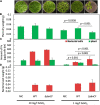Siderophore for Lanthanide and Iron Uptake for Methylotrophy and Plant Growth Promotion in Methylobacterium aquaticum Strain 22A
- PMID: 35875576
- PMCID: PMC9301485
- DOI: 10.3389/fmicb.2022.921635
Siderophore for Lanthanide and Iron Uptake for Methylotrophy and Plant Growth Promotion in Methylobacterium aquaticum Strain 22A
Abstract
Methylobacterium and Methylorubrum species are facultative methylotrophic bacteria that are abundant in the plant phyllosphere. They have two methanol dehydrogenases, MxaF and XoxF, which are dependent on either calcium or lanthanides (Lns), respectively. Lns exist as insoluble minerals in nature, and their solubilization and uptake require a siderophore-like substance (lanthanophore). Methylobacterium species have also been identified as plant growth-promoting bacteria although the actual mechanism has not been well-investigated. This study aimed to reveal the roles of siderophore in Methylobacterium aquaticum strain 22A in Ln uptake, bacterial physiology, and plant growth promotion. The strain 22A genome contains an eight-gene cluster encoding the staphyloferrin B-like (sbn) siderophore. We demonstrate that the sbn siderophore gene cluster is necessary for growth under low iron conditions and was complemented by supplementation with citrate or spent medium of the wild type or other strains of the genera. The siderophore exhibited adaptive features, including tolerance to oxidative and nitrosative stress, biofilm formation, and heavy metal sequestration. The contribution of the siderophore to plant growth was shown by the repressive growth of duckweed treated with siderophore mutant under iron-limited conditions; however, the siderophore was dispensable for strain 22A to colonize the phyllosphere. Importantly, the siderophore mutant could not grow on methanol, but the siderophore could solubilize insoluble Ln oxide, suggesting its critical role in methylotrophy. We also identified TonB-dependent receptors (TBDRs) for the siderophore-iron complex, iron citrate, and Ln, among 12 TBDRs in strain 22A. Analysis of the siderophore synthesis gene clusters and TBDR genes in Methylobacterium genomes revealed the existence of diverse types of siderophores and TBDRs. Methylorubrum species have an exclusive TBDR for Ln uptake that has been identified as LutH. Collectively, the results of this study provide insight into the importance of the sbn siderophore in Ln chelation, bacterial physiology, and the diversity of siderophore and TBDRs in Methylobacterium species.
Keywords: Methylobacterium species; heavy metal sequestration; lanthanide; lanthanophore; plant growth promoter; siderophore.
Copyright © 2022 Juma, Fujitani, Alessa, Oyama, Yurimoto, Sakai and Tani.
Conflict of interest statement
The authors declare that the research was conducted in the absence of any commercial or financial relationships that could be construed as a potential conflict of interest.
Figures







Similar articles
-
A Periplasmic Lanthanide Mediator, Lanmodulin, in Methylobacterium aquaticum Strain 22A.Front Microbiol. 2022 Jun 23;13:921636. doi: 10.3389/fmicb.2022.921636. eCollection 2022. Front Microbiol. 2022. PMID: 35814700 Free PMC article.
-
Lanthanide-Dependent Regulation of Methylotrophy in Methylobacteriumaquaticum Strain 22A.mSphere. 2018 Jan 24;3(1):e00462-17. doi: 10.1128/mSphere.00462-17. eCollection 2018 Jan-Feb. mSphere. 2018. PMID: 29404411 Free PMC article.
-
Lanthanide-Dependent Methanol and Formaldehyde Oxidation in Methylobacterium aquaticum Strain 22A.Microorganisms. 2020 May 30;8(6):822. doi: 10.3390/microorganisms8060822. Microorganisms. 2020. PMID: 32486139 Free PMC article.
-
TonB-dependent receptors in nitrogen-fixing nodulating bacteria.Microbes Environ. 2010;25(2):67-74. doi: 10.1264/jsme2.me10102. Microbes Environ. 2010. PMID: 21576856 Review.
-
Review of the genus Methylobacterium and closely related organisms: a proposal that some Methylobacterium species be reclassified into a new genus, Methylorubrum gen. nov.Int J Syst Evol Microbiol. 2018 Sep;68(9):2727-2748. doi: 10.1099/ijsem.0.002856. Epub 2018 Jul 19. Int J Syst Evol Microbiol. 2018. PMID: 30024371 Review.
Cited by
-
Metabolism-linked methylotaxis sensors responsible for plant colonization in Methylobacterium aquaticum strain 22A.Front Microbiol. 2023 Oct 13;14:1258452. doi: 10.3389/fmicb.2023.1258452. eCollection 2023. Front Microbiol. 2023. PMID: 37901831 Free PMC article.
-
Transcriptional Regulation of Methanol Dehydrogenases in the Methanotrophic Bacterium Methylococcus capsulatus Bath by Soluble and Insoluble Lanthanides.Microbes Environ. 2023;38(4):ME23065. doi: 10.1264/jsme2.ME23065. Microbes Environ. 2023. PMID: 38092408 Free PMC article.
-
Modulating metal-centered dimerization of a lanthanide chaperone protein for separation of light lanthanides.Proc Natl Acad Sci U S A. 2024 Nov 5;121(45):e2410926121. doi: 10.1073/pnas.2410926121. Epub 2024 Oct 28. Proc Natl Acad Sci U S A. 2024. PMID: 39467132 Free PMC article.
-
The Growth-Promoting and Colonization of the Pine Endophytic Pseudomonas abietaniphila for Pine Wilt Disease Control.Microorganisms. 2024 May 27;12(6):1089. doi: 10.3390/microorganisms12061089. Microorganisms. 2024. PMID: 38930471 Free PMC article.
-
Bacterial Siderophores: Classification, Biosynthesis, Perspectives of Use in Agriculture.Plants (Basel). 2022 Nov 12;11(22):3065. doi: 10.3390/plants11223065. Plants (Basel). 2022. PMID: 36432794 Free PMC article. Review.
References
LinkOut - more resources
Full Text Sources
Research Materials

